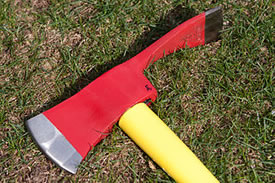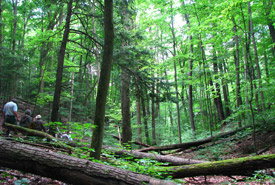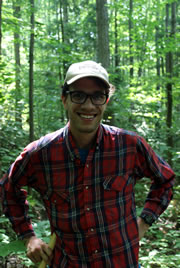I bought a pulaski

Pulaski (Photo by C0ntributor, Wikimedia Commons)
From the Latin names of plants to field equipment, the lingo in the conservation world can be complex. But the pulaski isn’t an endangered species or a scientific instrument. It’s not a normal part of the Nature Conservancy of Canada’s (NCC's) toolkit, but I’ve bought a pulaski for work in the Happy Valley Forest at the Goldie Feldman Nature Reserve and I think the property is better off for it.
The pulaski was originally built for another conservation purpose. It was used by forest firefighters for cutting firebreaks. But I’m not fighting fire in Happy Valley.
The pulaski is also a trail building tool. With a hoe on one end and an axe on the other, it’s the tool strapped to the backpack of any trail builder. Its multi-use head is perfect for turning the side slope of a hill into a level surface for walking and hiking — a technique called bench cutting.
So why is this tool important to my work of protecting hardwood forest in southern Ontario?

Happy Valley Forest Ontario (Photo by NCC)
Our natural areas aren’t only used by endangered species; they’re also the used by nature-loving Canadians for enjoying the beautiful outdoors. The problem is that without a good trail to follow, visitors will go through wet areas, up steep hills and off trail, causing erosion and other issues. Since Happy Valley is a one-hour drive from the heart of the Toronto we want to invite people here, but not at the risk of hurting the forest.
This is where the pulaski comes in. Trails that just happen without planning or work can become scars on the land and threats to our goals of protecting nature. In my previous work, I’ve seen hundreds of square metres of habitat eroded and literally left as exposed rock because of a badly routed walking trail. Walkers often end up in sensitive habitat if a trail isn’t easy to follow. Sometimes they end up bushwacking, which is bad for the land and is frustrating for people.
Armed with a pulaski and a plan, I’m making the existing official trail at the Goldie Feldman Nature Reserve in Happy Valley Forest a sustainable one. These trails are safer for walkers and easier to use. A bench cut trail helps to keep people on route, to shed water off the trail and prevent erosion. And a pulaski makes this work easy.
Sure, you can get by without a pulaski, but I wouldn’t want to. Earlier in the season volunteers joined me to help make some bench cut trail and all we had were shovels. I didn’t bring my pulaski — I knew once they used it they wouldn’t want to put it down.
NCC encourages people to get outside and get up close to what we think is so worth protecting. I love exploring new trails and I hope that the trails I’m making give people a chance to get outside, discover and be moved by nature. I know I’ve certainly had this chance while swinging my pulaski in the shade of one of the most beautiful forests in Southern Ontario.


